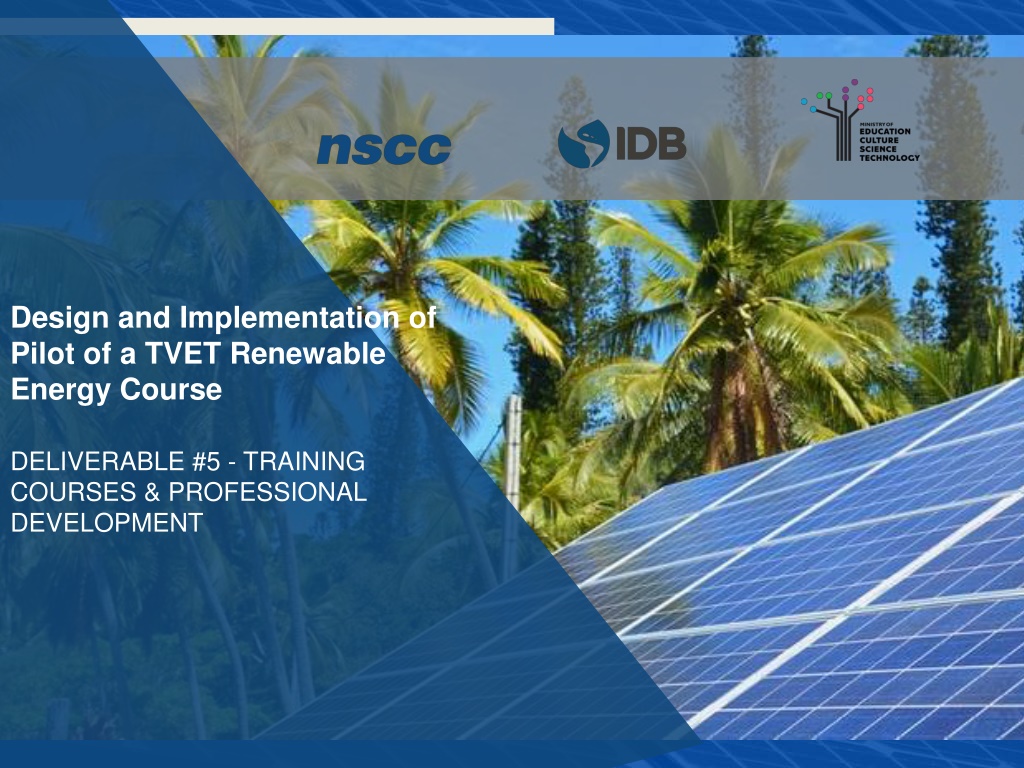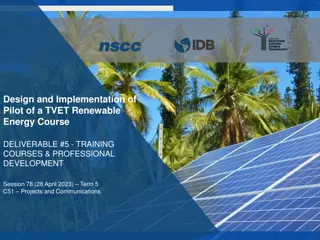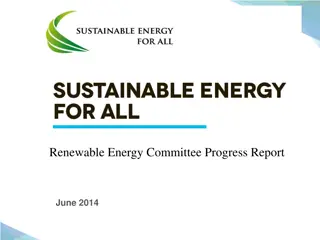Design and Implementation of Pilot of a TVET Renewable Energy Course
This module focuses on the practical lab activities related to Battery Based PV installations in a TVET Renewable Energy Course. It covers processes such as receiving, preparing for shipment, installation, and maintenance of flooded lead-acid batteries. Learners engage in simulating real-world scenarios, developing checklists, and understanding quality control procedures provided by Rolls and FULLRIVER companies. The module aims to enhance hands-on skills and knowledge in handling battery systems for renewable energy applications.
Download Presentation

Please find below an Image/Link to download the presentation.
The content on the website is provided AS IS for your information and personal use only. It may not be sold, licensed, or shared on other websites without obtaining consent from the author. Download presentation by click this link. If you encounter any issues during the download, it is possible that the publisher has removed the file from their server.
E N D
Presentation Transcript
Design and Implementation of Pilot of a TVET Renewable Energy Course DELIVERABLE #5 - TRAINING COURSES & PROFESSIONAL DEVELOPMENT
Battery Based PV This module explains four lab activities for the course Battery Based Installations: Receiving delivery of new flooded acid batteries. Preparing for shipment to customer. Installation of the batteries in the campus lab. Monthly maintenance of flooded lead acid batteries. Quarterly maintenance of flooded lead acid batteries.
Battery Based PV In the first lab, Receiving / Shipping of Flooded Batteries the learners will perform the necessary steps to simulate receiving delivery of new flooded acid batteries. Then to prepare the batteries to be shipment to a customer. Including providing documentation for both activities.
Battery Based PV The learner will be exposed to a real working event of receiving new flooded batteries that need to be accepted from a courier company. The batteries need to be examined before they are accepted and signed for. A check list will be developed for this process.
Battery Based PV After the batteries are accepted, they need to be conditioned for shipping to the customer. A check list will be developed for this process and the learners will sign off on the condition of the batteries before the potential shipment. These exercises are part of a quality control function that manufacturers and suppliers go through.
Battery Based PV Rolls and FULLRIVER companies provide some guidance on these procedures. Rolls has a very detailed approach to this, and the learners will practise performing these procedures in a lab setting. These procedure are found in the presentation Battery Based PV Installations.
Battery Based PV This presentation will provide a basic guide to these procedures that the learners can follow to develop their own check list for both the receiving and shipping of new flooded batteries. The lab activities will involve the four flooded batteries on campus. Four groups of students will each be assigned to one battery.
Battery Based PV Before handling the battery any SDS (Safety Data Sheet) must be read and fully understood. PPE (Personal Protective Equipment) must be identified and be used. Before using any PPE a check of the condition of such PPE must be had. A sign off sheet shall be used to track the condition of the PPE.
Battery Based PV Once these first steps have been observed by the instructor, permission to handle the battery is then allowed.
Battery Based PV From Rolls: EQUIPMENT & SAFE HANDLING PROCEDURE Have the following on hand: Goggles, rubber gloves & rubber boots Distilled water Baking soda, soda ash Hydrometer, refractometer Voltmeter, ammeter Battery charger
Battery Based PV To prevent injury, always wear acid-resistant clothing, PVC gloves, goggles and rubber boots. Flooded batteries must be maintained in an upright position at all times. Always have plenty of water and baking soda on hand in the event of an acid spill during transport.
Battery Based PV INSPECTION When receiving shipment of your batteries, it is important to thoroughly inspect each pallet, battery and packaging. Before signing acceptance of the shipment, remove the shrink-wrap from the pallet (if present) and inspect each battery for damage (i.e. cracks, dents, punctures, deformations, acid leaks or other visible abnormalities).
Battery Based PV Do not accept shipment if the batteries appear to have been damaged in any way. Confirm that connection terminals are secure and clean. If the battery is dirty, or if any minor amount of acid has spilled onto the case due to loose bayonets, refer to the cleaning instructions in the manual to properly neutralize and clean as necessary (look into this before starting).
Battery Based PV Wet pallets or signs of acid leak on or around the batteries could indicate shipping damage or improperly sealed battery casing. Perform a voltage check to confirm the battery polarity and marking of the terminals are accurate. In the event of a suspected leak or damage, do not accept the shipment.
Battery Based PV A check list with a place for comments, initials and date can be made for validating each step. Once signed off and the driver is released then move to preparing the battery for shipment. This involves replicating the conditions when they left the factory.
Battery Based PV INSPECTION & INITIAL CHARGE OF FLOODED LEAD-ACID BATTERIES WARNING ALWAYS WEAR THE PROPER PERSONAL PROTECTIVE EQUIPMENT (GOGGLES, GLOVES, CLOTHING) WHEN HANDLING FLOODED BATTERIES AND ELECTROLYTE. WET BATTERIES MUST BE FULLY CHARGED BEFORE BEING DELIVERED TO THE END USER.
Battery Based PV A battery may not be fully charged when received. An initial charge brings the battery to an operational state. Before charging, inspect for physical damage, check polarity and electrolyte levels in each cell. Ensure the electrolyte (liquid) covers the plates completely. (Have the check list complete)
Battery Based PV Although all Rolls batteries are tested and charged prior to shipping, batteries will self-discharge when stored and not in use. Upon installation, the initial charging may take 10+ hours or more depending on the size of the battery bank and charge current. Once the battery is fully charged, recheck the electrolyte level in the cell.
Battery Based PV The fluid should be 6-13mm (1/4 -1/2 ) below the vent tube on each cell as shown below. CAUTION: Do not add water or electrolyte to cells before initial charging unless plates are exposed. If so, add distilled water until plates are submerged.
Battery Based PV It is normal for electrolyte levels to lower as the battery case will relax (bulge) slightly after filling. If the plates are exposed, add distilled water until all are just submerged. It is important not to overfill each cell as the electrolyte level will rise during the charging process. Charge voltages are indicated in Table 2 (a) Flooded Charging Parameters.
Battery Based PV Rolls Table 2 (a) Flooded Charging Parameters.
Battery Based PV Measure specific gravity and record. Set up battery charge voltage / current limits of the charger. Can be solar charge controller in the campus lab. Do not let the cell temperature exceed 52 C (125 F). Use remote battery sensor for this.
Battery Based PV If the temperature becomes excessive or the cells begin to gas vigorously, reduce the rate of charge. Continue charging until all cells reach the specific gravity of the filling (Factory) acid. All cell specific gravities should be even (1.260- 1.280) when resting at full charge.
Battery Based PV All of these steps are required before the battery can be shipped out to the customer. Have the learners develop a complete check list to be supplied to the customer indicating: Voltage, specific gravity, battery condition. Provide date and signature.
Battery Based PV This concludes the information to complete lab #1 Receiving / Shipping Flooded Batteries.
Battery Based PV Lab #2 is the installation of the flooded batteries into the campus lab area. This involves having a permanent location to store the batteries. Providing the ability to recharge the batteries. Active ventilation for gassing.
Battery Based PV The batteries should be elevated on racking for safe and easy maintenance of the batteries. The OutBack charger / inverter FXR will be used to both charge the batteries and have the batteries supply AC energy for daily consumption. This activity will prove a living lab for the learners to access when they are on campus.
Battery Based PV Daily loads can be assigned as required. The Stand-Alone Course is being delivered at the same time as this course. Loads can be calculated in the Stand-Alone Course, the PC or TV or both are an option to be connected as AC loads (calculate first).
Battery Based PV The OutBack inverter / charger FXR is introduced during the Stand-Alone Course. The operating mode, charging parameters can be adjusted for the flooded batteries and supplying AC loads. Three modes support this configuration: UPS Back up Mini Grid
Battery Based PV In all three of these modes the inverter will supply power from the batteries. All three modes allow for the grid to charge the batteries. UPS and Back up require the intervention to open the AC breaker to indicate a grid failure. Choose any option and provide the necessary protection to prevent over discharge of batteries.
Battery Based PV The learning of this lab is the daily interaction to observe how the batteries will perform as in a Stand- Alone system. The learners will also see how batteries are to be stored / segregated from an open space. Placed in a safe location within the lab area. Complete with active ventilation.
Battery Based PV This allows the student to build a battery bank of four flooded batteries. Connections, wiring, over current and disconnection means as per manufacturer specifications. Torquing exercises, cable handling, and safe tool operations.
Battery Based PV This allows the student to build a battery bank of four flooded batteries. Connections, wiring, over current and disconnection means as per manufacturer specifications. Torquing exercises, cable handling, and safe tool operations.
Battery Based PV As part of the daily course, the building of this system will happen during regular classroom sessions. This requires access to the lab area during these times. Instructor lead sessions for planning and direction to the connection of the batteries, wiring and inverter.
Battery Based PV The calculation of the wire sizes, overcurrent protection is provided in the installation manuals for the equipment. The balance of equipment is readily available. Tools and a schedule of the installation shall be provided by the instructor.
Battery Based PV Programming of the OutBack inverter / charger FXR will depend on what mode is selected. The Stand-Alone Course provides guidance on how to program the FXR inverter. Manual is provided. The battery manufacturer will provide charge rates and the time for each of the three stages of charge.
Battery Based PV The time it will take to get the inverter operational is a variable that will be very difficult to determine. There is no deadline for this. Once the FXR is operational and AC loads are connected, the learners can build a battery log sheet. The Rolls logbook is another option for this.
Battery Based PV The learners can keep their four groups, one per battery to track and share the logged data. Taking reading during various times of discharge / charge will allow the students to build a profile of voltage, specific gravity and water levels. This exposure normally takes years for experienced battery maintainers to obtain. Maintain records for future classroom sessions.
Battery Based PV This data is a great tool for predicting battery performance. This concludes the second lab information.
Battery Based PV The next two labs are independent of the inverter operation. These labs are for learners to perform a monthly and quarterly maintenance routines on the battery bank. The first maintenance lab is the: Lab#3 Flooded Lead Acid Monthly Maintenance.
Battery Based PV The next two labs are independent of the inverter operation. These labs are for learners to perform a monthly and quarterly maintenance routines on the battery bank. The first maintenance lab is the: Lab#3 Flooded Lead Acid Monthly Maintenance.
Battery Based PV Monthly and quarterly maintenance for flooded lead acid batteries. The renewable industry needs people trained to do maintenance on flooded batteries as well as Lithium and other batteries. The next section will be on the monthly and quarterly maintenance of the flooded lead acid battery.
Battery Based PV Voltage Readings Voltage readings will vary and are greatly affected and dependent on whether the battery is being charged, discharged or in storage (rest or open cell voltage). There are two terms for voltage readings: Load voltage (voltage under load or on charge) Open cell voltage.
Battery Based PV Charge Voltage: When a battery is charged the plates will polarize and develop a resistance to the charge (surface charge). This resistance will add to the battery voltage and therefore using this voltage reading will not reflect the true state of charge.
Battery Based PV All the so-called surface charge will be removed when the battery is being discharged. In general, the battery voltage will recover or increase when the load is removed. This is especially true if the load is very high.
Battery Based PV Open Cell Voltage is determined by taking all the loads off of the battery and letting the battery stand for at least 4 hours before taking a reading. This allows the surface charge to dissipate. To get around this problem either use the table for SoC based on voltage (next slide) or determine the 50% state of charge as described.
Battery Based PV Table for % charged based on voltage. Rolls Technical Service
Battery Based PV The list of maintenance items is listed below: MONTHLY: Measure and record resting/loaded voltage. Check electrolyte levels and top up with distilled water as necessary. Test and record specific gravity in float charge. (https://www.youtube.com/watch?v=DgiII0OnAZg ) Rolls Technical Service
Battery Based PV Record ambient temperature where the batteries are installed. Inspect to ensure temperature sensor is securely attached. Inspect cell integrity for corrosion at terminal, connection, racks or cabinets. Rolls Technical Service
Battery Based PV Check battery monitoring equipment to verify operation. Compare reading against voltmeter Temperature readings What charging stage is it in. Update logbook and include and comments before initialing. Rolls Technical Service























